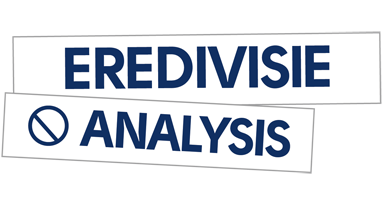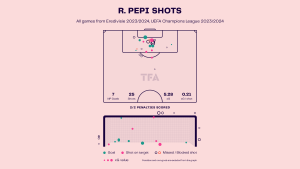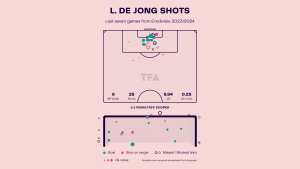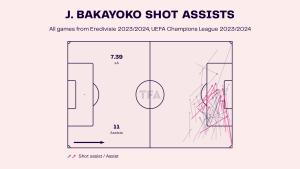Feyenoord welcomed fans back to De Kuip for the first time since the beginning of the COVID-19 measures were implemented in the Netherlands. They hosted Twente, with both sides coming into the game off the back of opening day victories in the Eredivisie. Dick Advocaat will be keen to lead Feyenoord to their first title since 2017 in his first full season at the club. Twente, on the other hand, are looking to reinstate themselves as a side who can compete for the Eredivisie title and UEFA Champions League places, as they did for the best part of a decade until their financial troubles.
The game finished 1-1 with the momentum changing for both sides as it went on. This tactical analysis seeks to break down the actions that led to the result in greater detail.
Lineups

Both teams lined up in 4-2-3-1 formations, however, this shape manifested itself differently in each side. Advocaat’s team set up in a manner that suggested they planned to utilise their apparent strength in attack. Full-backs Ridgeciano Haps and Lutsharel Geertruida (and later Bart Nieuwkoop who replaced Eric Botteghin early on) played in advanced positions in order to contribute to the attack. Wingers Bryan Linssen and Steven Berghuis pushed up to form a front three with Nicolai Jørgensen.
Similarly, Twente formed a front three to attack and press in, with Queensy Menig proving particularly dangerous on the left-wing. Much of their build-up play went through midfielders Godfried Roemeratoe and Ramiz Zerrouki who sat in front of a 4-man backline. This backline stayed flatter than their opponents’, with the full-backs refraining from venturing as far forward.
Twente’s press
Due to the popularity of the 4-3-3 formation in football at present, it’s not unusual to see teams pressing in a three. However, the success of Twente’s press came down largely to the danger that Jesse Bosch added to this phase.

The role of the front three was to put the initial pressure on the defenders and shape the press. As seen in the image above, the winger (Menig) drifts inside in order to try and press the man in possession while simultaneously cutting off a passing lane to the winger. A combination of the front three’s pressure on the defensive line and Zerrouki and Roemeratoe putting pressure on Feyenoord’s midfielders meant that any short “safe” passes forward or sideways were no longer available. This leaves Geertuida with two options: risk losing possession with a long ball or play backwards.
Bosch then adds another element to the press making it extremely difficult for Feyenoord to play out effectively. As an attacking midfielder, his position means he can press the ball as well as further limit forward passes. These tactics meant that Feyenoord oftentimes found their options too limited and were forced to restart their attack.

This second example shows Danilo leading the press, pressing higher up the pitch than anyone else. His angle of press cuts off central options, forcing the keeper to look to the wings and half-spaces. Bosch once again looks to press the receiver aggressively in order to intercept or force an error. Just as before, this leaves Feyenoord with the options of playing long balls and risking possession or retreating and risking being pressed further.

This kind of aggression in the final third is what helped Twente gain the upper hand early on in the match. The pressing intensity statistics show just how difficult it was for Feyenoord to adjust to this pressure in the opening stages. Their passes per defensive action (PPDA) score in the first 15 minutes shows that despite the fact they looked stronger on paper, they were unable to threaten Twente with a press of their own at this point.
Feyenoord in attack
Feyenoord employed two main methods of attack. The first was to play long penetrative passes through to the forwards, winger or overlapping full-back. The second was to build up across the pitch and look to play to an advancing full-back. Both of these will be examined in more detail in this section.

Feyenoord’s passing network shows that centre-backs Geertruida and Marco Senesi looked to break Twente’s midfield line by passing to wingers and advancing full-backs. This can be evidenced by the fact that Geertruida to Berghuis was one of the three most frequent passing combinations (WyScout).

Both men also attempted passes through the middle, often using Jørgensen as a target man.
The second attacking tactic used by Advocaat’s side was to attack down one wing and then combine to move laterally across the pitch. This allowed for the creation of space on the wing furthest from the man in possession. This can be put down to a tendency of defending teams to heavily overload the (vertical) half of the pitch occupied by the player in possession.

As illustrated in the above graphic, Steven Berghuis begins to build the attack by combining with Orkan Kökçü to move further inside.

This movement from Berghuis means that Twente’s defenders prepare to start defending zone 14, positioning themselves more narrowly. The assumption from Twente is that Feyenoord will look to go for goal either directly through Berghuis or by playing Jørgensen through. This reaction opens up space out wide for the full-back to exploit.

Feyenoord’s use of this type of attack can be evidenced by the heatmaps of full-backs (Nieuwkoop and Haps).
Feyenoord’s build-up play was effective, creating plenty of chances and ending up with an xG of 3.18 (WyScout). However, it was their failure to convert chances in the final third that cost them against Twente. WyScout statistics show that the Rotterdammers only managed 4 attempts out of 15 on target as well as low shooting accuracy scores for their front three. Steven Berghuis ended up with 40% accuracy and both Linssen and Jørgensen failed to register a shot on target.
Twente in defence
The pressing intensity analysis (see “Twente’s press”) shows that Twente became less aggressive after the first 15 minutes. They reduced their pressing intensity and tried to focus more on defending their lead than adding to it.

The above image shows Ron Jans’ side’s initial plan when out of possession. The forwards take up an advanced position to press defenders high up the pitch. Midfielders contribute just as much and even full-backs are prepared to play their part in the press should they need to.

The second image shows Twente sitting deeper and reducing the intensity of their press. Pressing at high intensity for another 75 minutes wouldn’t be viable, particularly against a team like Feyenoord who are superior on paper. They sat back in an attempt to absorb the Feyenoord attack and, if possible, threaten with counter-attacks through a front three who are capable of attacking at speed.
By this point, Feyenoord were starting to employ the use of their full-backs in attack, and by dropping the defensive line deeper it means there is less available space for the full-back to overlap into while remaining onside. While this can still be overcome through the use of well-timed and accurate passing; it makes it more difficult for Feyenoord to play through the defensive line.

This did however cause problems for Twente. Feyenoord continued to attempt long passes forward, particularly targeting full-backs Geertruida and Haps, however, Twente’s defensive unit struggled to maintain the right positions. The image above shows left-back Jayden Oosterwolde out of line with the other three defenders. This is dangerous as he leaves a pocket of space behind him in which an advancing wide player can receive in space while remaining onside.

Geertruida receives the ball in this space and ends up being brought down by Oosterwolde in the box. This lack of unity from the defenders (poor positioning from Oosterwolde) ends up leading to Feyenoord’s equalising goal.
Conclusion
From a tactical and statistical perspective, this game was far closer than it should have been. Feyenoord demonstrated that they are a team more than capable of creating chances but will need their forwards (particularly last season’s joint-top scorer Berghuis) to step up their game. With a front three who managed a combined total of 36 goals last season, Advocaat will be hoping that this performance isn’t a sign of things to come.
Twente are showing promise in attack with a forward line who are clearly capable of posing a threat to defences. Queensy Menig looks to be a player who could prove to be particularly dangerous, especially against teams outside of the big four of Ajax, Feyenoord, PSV and AZ. A top-half finish is well within the reach of the side from Enschede this season.









